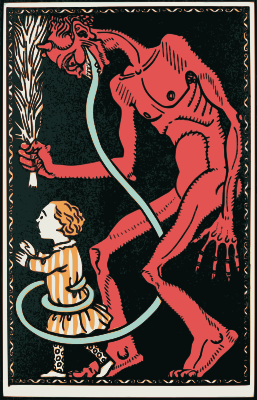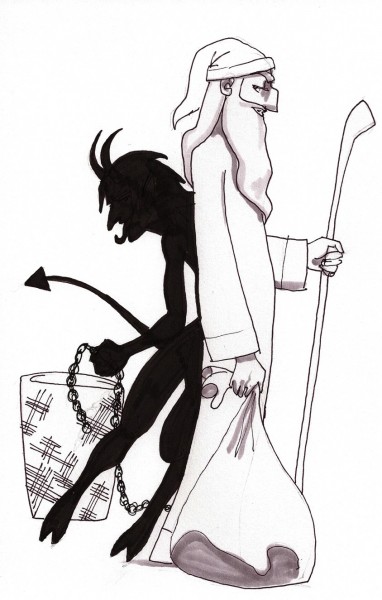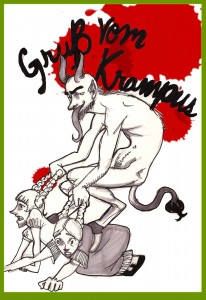
Though there is plenty of creepiness about a man who sneaks into our houses after spying on us all year to reward behavior that he deems good, Santa is far from the only holiday spirit to take on the job of keeping us all in line. Most of the witches and demons of Christmas time share this reward and punish vocation, but they haven’t all been painted as benevolent, harmless, and rosy cheeked as our dear old Claus.
Let’s begin with the Krampus. Krampus has been described as a half goat – half demon, and is one of the companions of St. Nicholas. St. Nicholas’ companions vary by region, share some similar characteristics, and seem to play the part of a shadow self or the evil side of the Saint. Where St. Nicholas rewards good girls and boys with gifts during Christmas time, the Krampus punishes naughty children by whipping them with bundled reeds, locking them in chains, and/or carrying them away in a woven basket he wears on his back. Krampus may be a vestige of pagan celebrations that pre-date Christianity; they have at times been forbidden by the Catholic Church. Lately, there has been a renewed interest in the Krampus that, because of modern humor and consumerism, some worry has been diluting the dark and violent truth of this Christmas creature.
Krampus is far from the only dark creature you might find during the winter holidays. Several cultures have tales of yuletide witches that both punish and reward as deserved. In Germany and Austria Perchta keeps an eye out for young women who do not abstain from their spinning on holidays, and those who have not yet finished their work on time. Individuals not observing the traditional fasting are also likely to be visited by Perchta’s wrath. This punishment, dear reader, is nothing to sneeze at. Far from simply whipping or chaining you, Perchta will disembowel you. After she has ripped your organs from your abdomen she will replace them with sticks, rocks, and garbage before sewing you back up again. Oddly, this punishment may have a silver lining. If you mend your ways, as much as you can with garbage inside you, then she may return with your safe and clean innards and undo her previous work. The lesson, in this case, is if you don’t take care of it you can’t have it anymore.

La Befana is a much more benevolent Christmastime witch. She travels around Italy during epiphany bringing gifts to good children. The story goes that the three wisemen stopped by her home looking for direction to the baby Jesus. La Befana did not know the way and neglected to join the 3 kings on their journey to Bethlehem. Not long after she regretted her decision and attempted to catch up to the 3 travelers. La Befana now travels in search of the Christ Child and leaving gifts as she goes. It has been hypothesized that La Befana is connected to the same ancient goddess as Perchta, Mother Holle, the Russian Baboushka, and Gryla.
Gryla, however, isn’t known for her kindnesses. She is an ogress, troll, or giantess, and the mother of the yule lads, seven (or thirteen) mischievous spirits who wreak havoc during Christmas time. Gryla may have multiple heads, and multiple tails, or she may simply have been an embroidered demonization of a ‘parasitic’ beggar woman. Whatever her appearance, her raison d’être is eating children who don’t obey their mother.
So, if you didn’t already think Christmas time was a time of darkness and a time to fear that which lurks in the shadows outside your door, you now have a whole host of new imagery. To me the ancient fears of demons and witches explain some of the more beautiful aspects of the holiday season, that of banding together with family and helping your neighbors. Krampus, Perchta, and Gryla may get you if you do not.
References
- Basu, Tanya (2018) Who is Krampus? Explaining the horrific Chirstmas beast. National Geographic online. https://www.nationalgeographic.com/news/2018/12/131217-krampus-christmas-santa-devil/
- Cellania, Miss (2017) 8 Legendary Monsters of Christmas. Mental Floss. https://www.mentalfloss.com/article/54184/8-legendary-monsters-christmas
- Icelandic Christmas Lore (2019) Wikipedia. CC-BY-SA. https://en.wikipedia.org/wiki/Icelandic_Christmas_folklore#The_trolls_Gryla_&_Leppaludi
- Krampus (2019) Wikipedia. CC-BY-SA. https://en.wikipedia.org/wiki/Krampus
- Troop, Sarah E. (2013) The Monsters of Christmas. Atlas Obsucra. https://www.atlasobscura.com/articles/monsters-of-christmas
- Raedisch, Linda (2019) The Old Magic of Christmas: Yuletide Traditions for the Darkest Days of the Year. Llewellyn Publications: Woodbury, Massechusets.
- Ridenour, Al (2016) The Krampus and the Old, Dark Christmas: Roots and Rebirth of the Folkloric Devil. Feral House: Port Townsend, Washington.
- Sutherland (2019) Gryla: Cannibalistic, Evil Troll And Her Sons ‘Yule Lads’ – In Icelandic Folklore. Ancient Pages. https://www.ancientpages.com/2019/12/11/gryla-cannibalistic-evil-troll-and-her-sons-yule-lads-in-icelandic-folklore/


 Here is my Christmas card this year, inspired by Krampus cards from Victorian times. I’m still reeling from having a started and completed novel project for November. But now there are comic pages to draw, and old projects to get back to. I intend to make good use of my holiday vacation week.
Here is my Christmas card this year, inspired by Krampus cards from Victorian times. I’m still reeling from having a started and completed novel project for November. But now there are comic pages to draw, and old projects to get back to. I intend to make good use of my holiday vacation week.